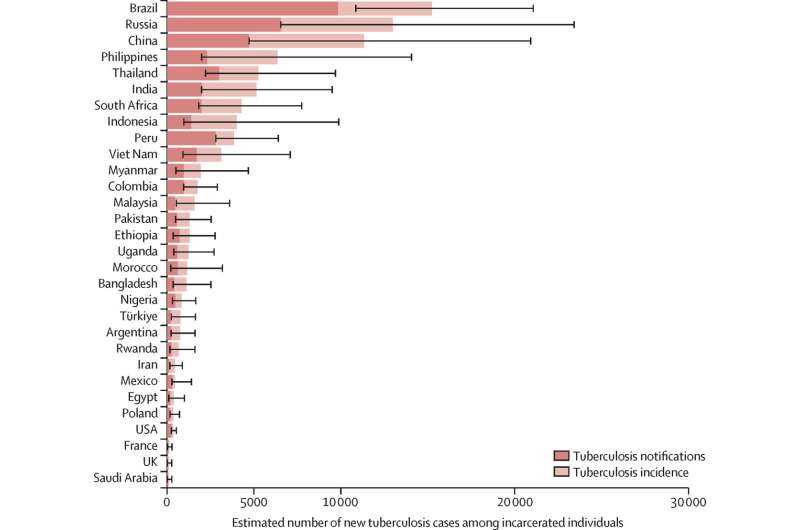This article has been reviewed according to Science X's editorial process and policies. Editors have highlighted the following attributes while ensuring the content's credibility:
fact-checked
peer-reviewed publication
trusted source
proofread
Nearly half of tuberculosis cases in prisons worldwide go undetected

In the first global assessment of tuberculosis (TB) among incarcerated people, a new study found consistently high TB case rates and low case detection in prisons, suggesting the need for health organizations to increase efforts to reduce the spread of TB among this high-risk population.
In 2019, incarcerated people across the globe developed TB at nearly 10 times the rate of people in the general population, according to a new study led by Boston University School of Public Health (BUSPH).
Published in The Lancet Public Health, the study found that 125,105 of the 11 million people incarcerated worldwide developed tuberculosis in 2019, a rate of 1,148 cases per 100,000 persons per year.
Despite this high case rate, nearly half of TB cases among incarcerated people were not detected.
The findings reveal the first global and regional estimates of new TB cases among incarcerated people, a population at high risk of developing this life-threatening disease. Collectively, the high case rate and low detection underscore the need for greater awareness and resources to reduce the burden of TB in prisons and other high-risk settings.
"Our study showed that only 53% of people that develop tuberculosis in prisons are diagnosed, which suggests that incarcerated people are neglected and have minimal health care services to diagnose tuberculosis," says study lead and corresponding author Dr. Leonardo Martinez, assistant professor of epidemiology at BUSPH.
To better understand TB rates among this population, Dr. Martinez and colleagues acquired data from published research and from countries' federal officials to analyze TB prevalence and incidence in 193 countries at the country, regional, and global level between 2000–2019. The team also calculated TB case detection rates per year in each country for 193 countries.
The African region had the highest rate of new TB cases in 2019, at 2,242 cases per 100,000 persons per year, but the Americas region—largely driven by Central and South America—had the greatest number of total cases, which increased nearly 90% since 2000. The countries with the highest number of new cases in prisons in 2019 were Brazil, Russia, China, the Philippines, and Thailand.
Importantly, the team found that new TB case rates remained consistently between 1,100 and 1,200 cases per 100,000 persons per year from 2012–2019.
"This stagnation suggests that current tuberculosis control policy in prisons is insufficient to decrease the tuberculosis burden and that supplementary interventions and policy implementation are needed," says Dr. C. Robert Horsburgh, professor of global health at BUSPH.
Mass incarceration is one major driver of TB transmission—both inside and outside of prisons. Overcrowding, where some prison cells contain up to 30 people, causes TB to "spread like wildfire," Dr. Martinez says, and this transmission can spill over easily into the community.
"Contrary to popular belief, persons that are incarcerated are a mobile population, and in many countries, the duration of incarceration is very short," he says. "People go into prison, then come out, then may go back in again. So, very often, people that develop tuberculosis in prison end up transmitting the disease to many people outside of prison once they are released. Since almost half of people with tuberculosis in prisons are not diagnosed, many still remain infectious when they enter back into the general community."
The team hopes that these findings will encourage global and regional health organizations to develop routine monitoring of TB among incarcerated people, as they do for other high-risk populations such as people with HIV and household contacts.
The researchers say that their comprehensive compilation of TB case notifications—which they retrieved directly from federal officials, national and regional organizations, and non-governmental organizations—is a clear indication that information about TB in prisons is both accessible and retrievable by global organizations such as the World Health Organization.
The team is currently working with several health organizations to attempt to update global guidelines on how to manage and reduce TB in prisons, as the most recent guidelines were written in the year 2000.
"One of the reasons this population is so neglected is because of the lack of data," Dr. Martinez says. "Our hope is that these results can help stakeholders understand the urgency of the issue and the amount of people in prisons that develop tuberculosis and remain undiagnosed for long periods of time and can spur them to take action."
More information: Leonardo Martinez et al, Global, regional, and national estimates of tuberculosis incidence and case detection among incarcerated individuals from 2000 to 2019: a systematic analysis, The Lancet Public Health (2023). DOI: 10.1016/S2468-2667(23)00097-X


















